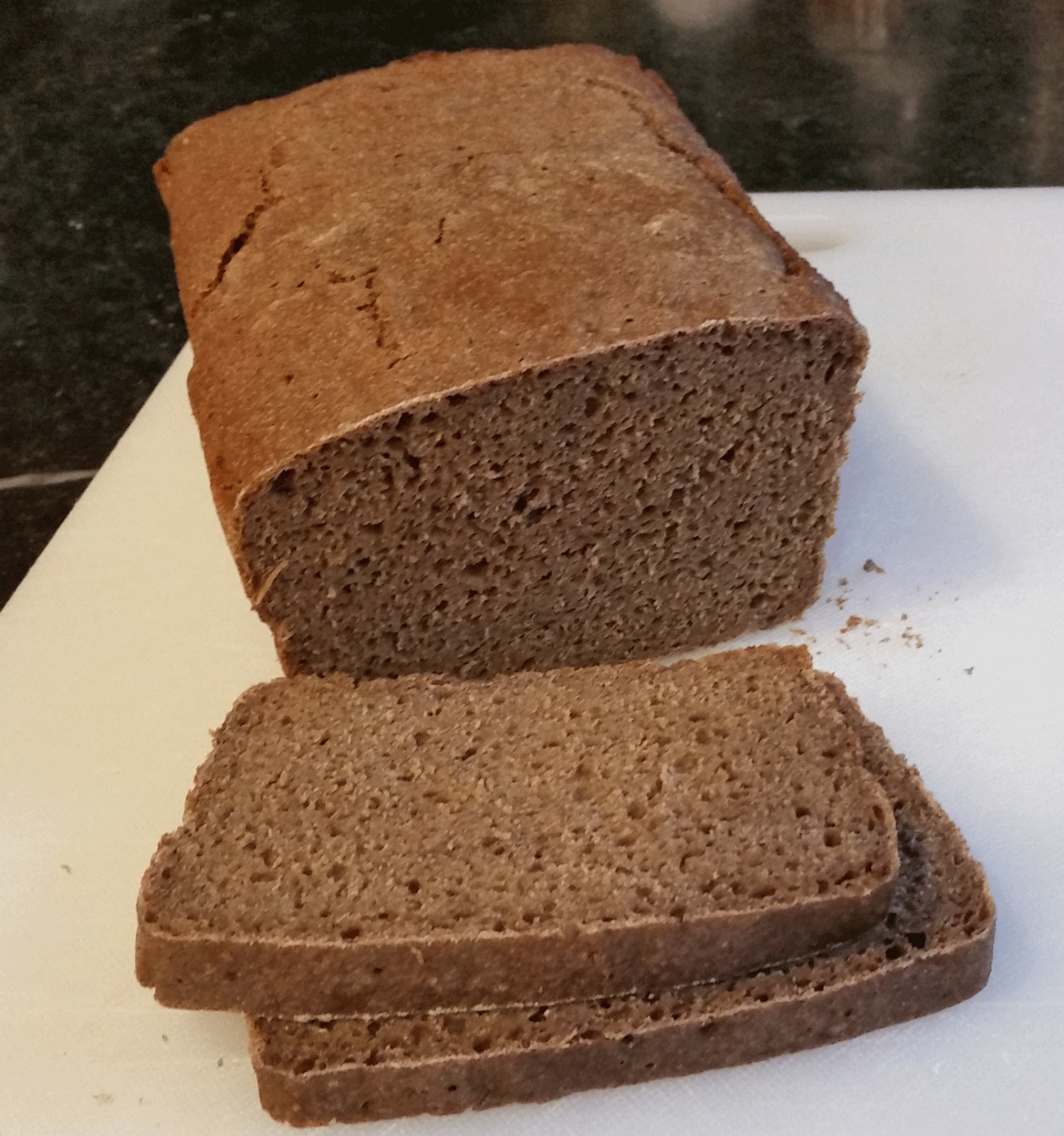February 14, 2016 - 4:03pm

An outstanding Russian rye bread -- Moskovskiy Rzhannoye Khleb

I'm a great fan of Russian rye breads: I love their dark color, intensity and the complexity of their flavor profiles. This one is one of the best I've baked so far -- a tender, open 100% rye crumb, the spiciness of rye and cumin, chocolate notes from the red rye malt and an amaizingly delicate, well-balanced sour finish.
The formula, which consists of a sponge, a scald and a yeasted scald-sponge (opara), in addition to the final dough, is here. Enjoy!
Stan


I have a few questions/comments.
1. Why medium rye? This is supposed to be a whole rye bread.
2. Why on earth cumin? It's never cumin, always caraway.
3. Why there is yeast in the sponge? And so much too?
4. The formula is wrong. It's based on a calculation for 500 g. of flour (including malt) but your final dough is ~50 g. short.
1. I prefer medium rye because it produces a slightly less dense crumb; where does it say that it's "supposed" to be a whole rye bread, and a bread can't get more "whole" than 100%, or can it?
2. Never say never. Cumin is used widely in breads throughout Eastern Europe, as are coriander and, yes, caraway. What's your basis for saying "always caraway"?
3. Yeast is often used when sponges are primarily used for acidification; these are called Type II sponges and focus on LAB, rather than yeast activity. I'm sorry, but I can't see how 1 gram, or 0.7%, of instant yeast in a sponge containing nearly 300g of flour is "so much."
4. In what way is the formula wrong? What's your authority and what formula have you been using?
I don't mind the questions, but kindly back up your assertions with fact and/or other useful information.
Stan
1. Re: whole rye. It says so in the original formula which I attached at the end. Let's not pretend that it looks like I meant "whole" as in "less than 100%" and not whole grain.
2. Cumin is a southern spice. It has only became available and popular in Russia in recent decades with the rise of familiarity with Indian, Middle Eastern, and Central Asian cooking. In point of fact, cumin still does not have an agreed upon name in Russian, and it's not to be found in the dictionaries. Its use in English language recipes for Russian (and Polish for that matter) breads, stems entirely from incorrect translation.
3. This particular recipe calls for 0.1% of compressed yeast, which comes to .17 g of instant for a 500 g. of flour, and in my experience, with properly raised sour it is not required.
4. The formula is attached. What you have is based on that. I do not know what route it took before you got ahold of it, I but I do have some theories.
I used the formula that appears in your site, О хлебе. Yes, the recipe does specify ржаной обойной муки, wholegrain rye, but as I noted earlier, I prefer the lighter flavor and more open crumb that comes from medium rye, which contains about 1.45% ash (0% moisture), versus about 1.95% for wholegrain. As for the yeast, again, that was my decision: your recipe calls for "a small amount, if desired," щепотка сухих дрожжей - при необходимости. I don't see where you get 500g of flour; your recipe calls for 470g.
I really enjoy your blog and find it a tremendously rich resource for Russian baking; in fact, I cite it in the "Sources and Resources" chapter in my upcoming book, "The Rye Baker."
Notwithstanding my liberties, it's still a terrific bread. Where did you get the version you posted? Auermann?
Stan
Russian books calculate malt as part of total flour, so with malt it comes to 505 g. Extra 5 grams come from a rounding errors - I typically round the numbers to the nearest 5 or 10, that makes it easier to keep them in my head without referring to cheat sheets.
Personally, I think that much of the difference between whole and medium rye comes from atrociously coarse grinds of whole rye you often find in the US. I always remill my whole rye flour, which makes for much smoother bread with better crumb structure and more palatable texture.
Auerman has never been a primary source of recipes, first and foremost it's a college textbook for the future industrial bakery technologists. I think for the past six decades or so it did not even have any recipes. In addition, sometimes his recipes for no discernible reasons drastically differ from contemporary literature. No, the recipes come from a series of plant manuals published (mostly) by the Ministry of Food Industries. Some of them are fairly common, like the final Soviet edition of the 1989. Some are next to impossible to get a hold of.
Your blog is a great resource. I haven't found a better authority for Russian breads. Thanks for setting it up.
BTW, I have a pdf copy of Auerman and was disappointed that it didn't contain more formulas although I'd heard that later editions had more breads.
Also I agr= with you about the grind of wholegrain rye. Instead of regrinding, I blend 55% medium rye and 45% dark rye. The protein/ash content is virtually identical with whole rye.
Someone still makes proper Hofmuller-type dark rye? I am amazed.
I appreciate your kind words but there other people who bake exceptionally well.
I use Bay State Milling's dark rye, which contains about 14% protein and 3.10% ash. I also it sell at at my website, nybakers.com
I revised the recipe in my blog. Thanks again!
nice de-escalation there Stan, I was about ready to block the guy for being so arrogantly rude.
I'm always looking for good rye recipes.
I never quite understood whether cumin and caraway were differentiated in Russia. My Russian family members tend to refer to a really wide range of things as "tmyn" (which I thought meant thyme, but appears to refer to a lot of different seeds). What's the deal with that? I'd really like to know, as the biggest obstacle I face in baking from Russian recipes is figuring out how to translate some of the ingredients.
It is even an obstacle for the Russians themselves.
It really isn't unless one is into deluding themselves. Although I guess it makes it an asked and answered situation.
Stan,
Looks like you start the sponge early morning, the scald at noon and the opara mid-afternoon, and then the opara sits 3-3.5 hours (until say 6pm?).
So does this mean that I can combine these parts and begin mixing the final dough around 6-7pm the same day and have the loaf in the oven before I go to bed that night? I have been working through the rye recipes in "Inside the Jewish Bakery" recently and those are all 2-day recipes. Just wanting to make sure I understand what you're doing here.
Thanks!
- Greg
This is a one-day bread. If you start it early, say at 7:00am, you'll have a finished loaf by 8:00pm or so. That's because most of the fermentations are carried out at higher than room temperature, which gooses the microorganism activity in the sponge and opara.
Stan
tasty 100% rye bread. I think I would dump the yeast since it isn't needed or replace it with a small YW levain, Breads like these are why we make red rye malt!
Happy baking Stan
I'm not a rye expert (first attempt was this weekend!) but your loaf looks beautiful, the crumb looks great. There's hope for me yet!
Please could you (or anyone else) shed some light on what you meant by the sponge being used for acidification?
Acid environments inhibit the activity of amylase enzymes, which degrade the starchy gels that make up rye doughs (not gluten). That's the reason a lot of rye breads use a sourdough. When the sponge is left for a couple of days, it becomes very acid and the yeast activity slows, so it's often necessary to use commercial yeast when a recipe calls for one of these highly acid sponges.
Thanks for the response! :)
but I have to agree with Suave in so far that it is very likely that cumin in a recipe for a German or Eastern European bread is a translation error.
I found this for example in one of Daniel Leader's formulas, where the German term for caraway = "Kümmel" was falsely translated with cumin = "Kreuzkümmel" in German.
Karin
Unfortunately, the word for cumin and for caraway is the same in Russian: TMIN, so without familiarity with the original, it's an easy mistake to make. In future, I'll make it with caraway.
In Russian tmin always means caraway, cumin is called either kumin or zira, the latter being far more common.
Thank you!
while nibbling on whole seeds of caraway, cumin, dill, fennel, and anise that they all have some flavor similarities to each other. And if I'm not mistaken, at least a few of them are all related to wild carrot. The amount of cumin you use in this formula is so small that it seems like it would be a subtly nuanced background flavor rather than an in-your-face spice.
It would be an interesting experiment to bake a loaf with each of these and see how they compare with one another. Not traditional by any stretch of the imagination, but interesting nonetheless.
--Mike
with each spice would defeat the purpose. It's the combination that makes the kick and it can vary widely according to region and availability. That is why I like it when Stan gives the ratios when listing spices. A good mix is when there isn't a dominating spice but a harmonious blend. Then again... a little bright flavour for a special occasion is nice too.
Stan,
In your recipe you start with "20g of rye seed culture". Is this the same 78% hydration (55g water / 70g rye flour) that you have in your book, or is it a different hydration?
Planning to make this bread this Saturday!!
- Greg
hi Greg,
I make my starter at 100% hydration, so rye flour (whole or medium) 100%, water 100%, rye starter 10%. Let it sit 8-10 hours at room temperature, at which time it will double or triple in volume and become very bubbly.
Good luck with the bread and keep us posted.
Stan
Glad to hear you use a 100% starter, as I found the 78% rye starter from the book a bit difficult to work with. Just not enough water to easily get all the flour incorporated. I've actually switched mine to a 100% starter, so that makes this weekend's bake REALLY easy!
Thanks Stan!
Stan, do you make your red rye malt (see dabrownman's post on it) or dou you purchase it?
having been there a few times, and loving their bread, I haven't even really tried to duplicate at home, seems a bit complicated but maybe with this I'll try, thanks.